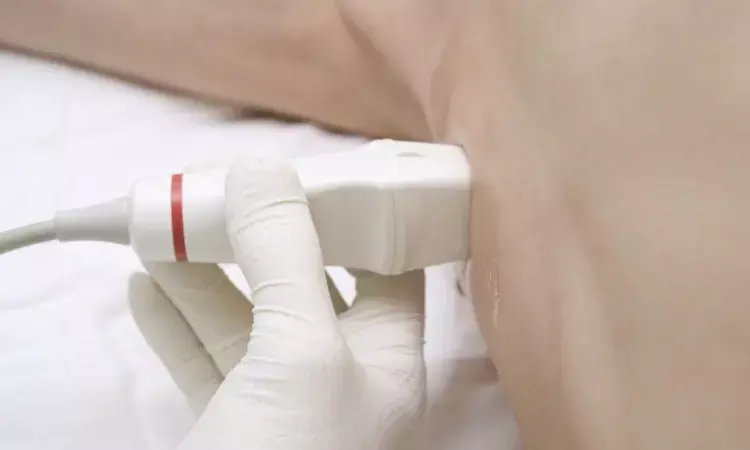- Home
- Medical news & Guidelines
- Anesthesiology
- Cardiology and CTVS
- Critical Care
- Dentistry
- Dermatology
- Diabetes and Endocrinology
- ENT
- Gastroenterology
- Medicine
- Nephrology
- Neurology
- Obstretics-Gynaecology
- Oncology
- Ophthalmology
- Orthopaedics
- Pediatrics-Neonatology
- Psychiatry
- Pulmonology
- Radiology
- Surgery
- Urology
- Laboratory Medicine
- Diet
- Nursing
- Paramedical
- Physiotherapy
- Health news
- Fact Check
- Bone Health Fact Check
- Brain Health Fact Check
- Cancer Related Fact Check
- Child Care Fact Check
- Dental and oral health fact check
- Diabetes and metabolic health fact check
- Diet and Nutrition Fact Check
- Eye and ENT Care Fact Check
- Fitness fact check
- Gut health fact check
- Heart health fact check
- Kidney health fact check
- Medical education fact check
- Men's health fact check
- Respiratory fact check
- Skin and hair care fact check
- Vaccine and Immunization fact check
- Women's health fact check
- AYUSH
- State News
- Andaman and Nicobar Islands
- Andhra Pradesh
- Arunachal Pradesh
- Assam
- Bihar
- Chandigarh
- Chattisgarh
- Dadra and Nagar Haveli
- Daman and Diu
- Delhi
- Goa
- Gujarat
- Haryana
- Himachal Pradesh
- Jammu & Kashmir
- Jharkhand
- Karnataka
- Kerala
- Ladakh
- Lakshadweep
- Madhya Pradesh
- Maharashtra
- Manipur
- Meghalaya
- Mizoram
- Nagaland
- Odisha
- Puducherry
- Punjab
- Rajasthan
- Sikkim
- Tamil Nadu
- Telangana
- Tripura
- Uttar Pradesh
- Uttrakhand
- West Bengal
- Medical Education
- Industry
Routine axilla scanning may be omitted for all diagnostic breast ultrasound exams

USA: Routine axillary scanning in all patients undergoing a diagnostic breast ultrasound gives a low rate of incidental findings; and has minimal impact on the detection of cancer, a recent study published in Clinical Imaging has found.
The researchers stressed that such scanning of the axilla may not be required. They found less than 1% of incidental axillary findings were given a BI-RADS category 3 or 4, none of which led to the diagnosis of occult breast cancer.
The researchers wrote, "Eliminating axillary scanning for all diagnostic breast ultrasounds may reduce patient anxiety related to unnecessary follow-up and biopsies and save time without any negative impact on patient care."
Breast ultrasound is a valuable modality in women undergoing diagnostic and screening breast imaging. However, the authors note that it can be time-consuming to perform and have high false-positive rates,
While axilla scanning is suitable for assessing axillary lymphadenopathy, it may be optional for women with a low likelihood of breast cancer. One side effect of the COVID-19 vaccine and booster is axillary lymphadenopathy; most cases resolve independently.
Iris Chen, David Geffen School of Medicine at UCLA, California, USA, and colleagues aimed to evaluate the clinical impact of incidental axillary findings found on diagnostic breast ultrasounds at a single multi-site institution with a standard protocol of axilla scanning for all breast ultrasound exams.
For this purpose, the researchers retrospectively reviewed all diagnostic breast ultrasounds from 2017 to 2019. They also studied the relevant clinical history, follow-up imaging, and pathology results. All positive axillary findings were categorised into incidental or non-incidental findings depending on the presence of a direct clinical indication to scan the axilla.
The authors reported the following findings:
· Of the 19,695 diagnostic ultrasounds performed during this timeframe, 91 (0.5%) incidental axillary findings were given a BIRADS category 3 or 4. None of these findings resulted in the diagnosis of occult breast cancer.
· One biopsy-proven SLL/CLL lymphoma that was otherwise clinically occult was diagnosed.
"We have shown that reducing unnecessary axillary scanning would lead to lesser false positives without missing any occult breast cancers," the authors wrote.
The low abnormal interpretation rate may be partly related to the experience of technologists and radiologists, along with mildly prominent lymph nodes being classified as benign. "Routine scanning of the axilla for all diagnostic breast ultrasound exams can be omitted," they conclude.
Reference:
Chen I, Kitich A, Joines M, Sayre J, Dascalos J, Hoyt A, Milch H. To scan or not to scan: effect of scanning the axilla of all patients undergoing diagnostic breast ultrasound. Clin Imaging. 2023 Apr 6;99:33-37. doi: 10.1016/j.clinimag.2023.03.019. Epub ahead of print. PMID: 37060679.
Dr Kamal Kant Kohli-MBBS, DTCD- a chest specialist with more than 30 years of practice and a flair for writing clinical articles, Dr Kamal Kant Kohli joined Medical Dialogues as a Chief Editor of Medical News. Besides writing articles, as an editor, he proofreads and verifies all the medical content published on Medical Dialogues including those coming from journals, studies,medical conferences,guidelines etc. Email: drkohli@medicaldialogues.in. Contact no. 011-43720751


